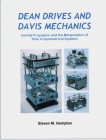From hoverflies to solid-state star drives, author and inventor Steven Hampton discusses gravity and the nature of inertial flight. He describes how Dean Drives lay waste to the basic notion of simultaneity in Newton\'s Third Law of Motion and why inertial propulsion does not violate the Conservation laws.
Invented by Norman L. Dean in 1958 and proven mathematically viable by William O. Davis, Ph.D. in 1962, inertial propulsion (IP - also known as Impulse Drive, Inertial Engines, Inertial Drive and Centrifugal Force Engines) has now become a force to be reckoned with: Physicists can no longer turn their heads.
Hampton exposes the principles that make an eccentric Dean rotor propel its frame. Based on the Dean Drive - but not exclusive thereof - Hampton\'s latest invention the Reciprocating Impulse Drive RID), loses over 70% its weight while running on a floor scale. It also aggressively tilts a heavy balance beam against its own weight and holds its position. It can deflect itself from zenith hanging as a pendulum. His earlier prototypes not only led up to this powerful machine, but created the foundation for a hovercraft inertial engine design (complete with patent drawings) that could revolutionize transportation as we know it.
Find out why it\'s not just motion that governs this new physics, it\'s time. By isolating inertial frames, we can change time within parts of a cycle - in ANY cycle - opening vast avenues of research into multi-dimensional technologies.
Finally, Hampton describes in great detail a theoretical model for a \"Free Energy\" machine as well as a solid-state drive wafer (the Burnett Drive) both based on Dr. Davis\'s mechanics. A copy of Dean\'s two famous patents are included as two additional PDF files for easy reference.
This book is an intellectual adventure with startling surprises. E-book format only: printed out at 8 1/2 x 11 to 201 pp. with 53 color photos, 80 detailed illus. ? Steven M. Hampton ISBN 518 373.



